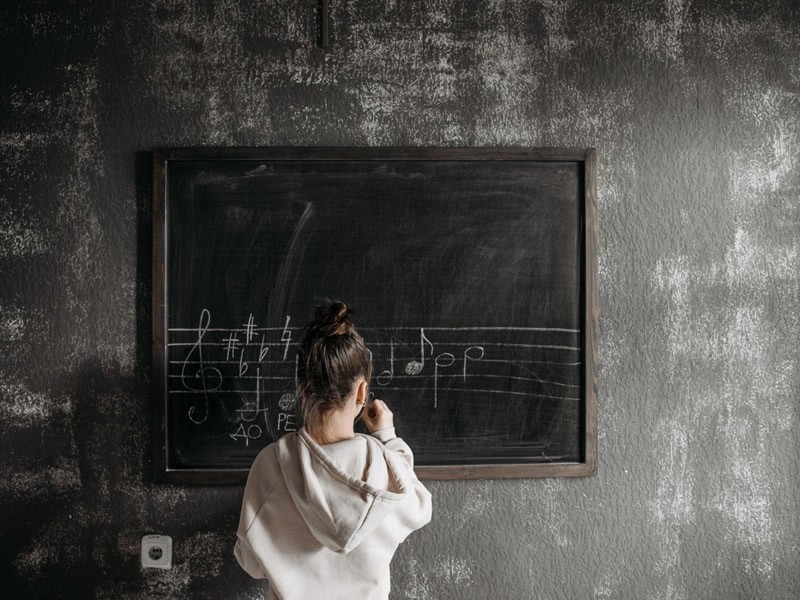Insight Blog
Agility’s perspectives on transforming the employee's experience throughout remote transformation using connected enterprise tools.
6 minutes reading time
(1292 words)
An In-Depth Look at Teaching Music Through Collaboration Tools
The advent of music collaboration tools has ushered in a new, modern era of teaching and learning, transforming traditional classroom settings into interactive, engaging, and virtually limitless environments.
As the digital revolution continues to shape various industries, education - and more specifically, music education - is no exception.
The advent of music collaboration tools has ushered in a new, modern era of teaching and learning, transforming traditional classroom settings into interactive, engaging, and virtually limitless environments.
This article explores the multifaceted role of music collaboration tools in enhancing music education.
From understanding the basic structure of these tools, to practical strategies for their integration into the teaching process, their impact on student engagement, and a glimpse into the future of music education, we delve into the intricate interplay between technology and pedagogy in the context of music.
Understanding Music Collaboration Tools: An Overview
In the ever-evolving landscape of the music industry, music collaboration tools have emerged as critical assets for artists and educators alike. These innovative platforms offer a digital space where musicians can create, edit, and share their own music with fellow artists or their mentors, irrespective of their geographic location.
Notably, these platforms are equipped with a plethora of mastering tools, such as EQ plugins and mastering compressors, to enhance the sound quality of the production. Some platforms, like Apple Music, even offer a vast library of music to draw inspiration from.
Whether one is a music producer with years of experience or a novice experimenting with their first track, music collaboration platforms cater to every user's need, making them a one-stop solution for many in the music industry.
Incorporating Collaboration Software into Music Teaching: Practical Strategies
The incorporation of music collaboration software into music education is not just a trend, but a response to the growing digital orientation of society. In the mastering process, these tools allow students to work with the best mastering plugins, under the guidance of a mastering engineer or their teacher, to learn about the intricacies of the mastering chain.
Using these platforms, teachers can set up virtual classrooms, assign projects, and provide real-time feedback on student work. To enhance their projects and captivate audiences, students can also experiment with audio visualizer free tools like Viddyoze or Beatwave to transform music into mesmerizing visual patterns.
While collaboration tools are revolutionizing music education, they can also play a pivotal role in distribution. For instance, budding artists looking to get their work onto major platforms like DistroKid for distribution, allowing seamless access to Spotify, Apple Music, and more. With such tools at both the educational and professional levels, the digital era significantly enhances the music journey for students and professionals alike. Additionally, students gain hands-on experience in music production and learn to use professional-grade tools.
This not only equips them with the skills required in the modern music industry but also motivates them to explore their creative potential.
And keeping up-to-date with the top mastering plugins is essential for both educators and students, as it allows them to explore the full potential of music collaboration platforms and deliver professional-quality sound.
Enhancing Student Engagement through Virtual Music Collaboration
Music collaboration websites and platforms offer unique ways to enhance student engagement in music education.
Students can form virtual bands, collaborate on compositions, and share their work with a global audience, fostering a true sense of community and shared purpose.
These collaborative efforts often lead to higher levels of engagement as students are not merely learning about music theory but are applying it in a practical, interactive, and fun manner.
They gain exposure to the same mastering plugins and tools used by music producers in the industry, which can spark their interest further.
Indeed, the advent of music collaboration platforms has created a dynamic shift in music education, one that aligns with the digital realities of today's world.
Follow us and access great exclusive content everyday: Follow us on Google News
Real-world Impact: Examining the Transformative Role of Collaboration Tools in Music Classrooms
Collaboration tools are transforming music classrooms worldwide by opening new avenues of learning and collaboration. An example of this is seen at the Berklee College of Music, which has effectively integrated collaboration tools in its curriculum.
Students, under the guidance of experienced mastering engineers, use music collaboration platforms to work on projects, sharing ideas and giving feedback in real time. By using the best mastering plugins, EQ plugins, and mastering compressors, they understand the intricacies of the mastering process, thereby enhancing their learning experience.
This hands-on experience in the virtual space replicates the workflow of the music industry, preparing students for their future careers.
Challenges and Solutions: Navigating the Learning Curve of Music Collaboration Software
While music collaboration tools bring numerous benefits, educators must also navigate certain challenges. These include the learning curve associated with mastering tools, the mastering chain, and new platforms. Teachers may need training to effectively use these tools and teach students.
Also, sound quality varies across different tools, requiring educators to choose wisely to ensure a superior music production experience for students. However, platforms like Apple Music and others have responded to these challenges with intuitive user interfaces, quality mastering plugins, and extensive support material to ease the learning process.
You may also like: Best Apps for Employees: UPDATED 2022 – A Complete Guide
The Future of Music Education: A Projection on the Role of Collaboration Tools
As technology advances, so does the future of music education.
Music collaboration websites, apps, and platforms are set to play a pivotal role in this evolution. The integration of AI with these tools will provide students with personalized feedback, refining their music production skills.
As more schools adopt these tools, they will increasingly become standard practice in music education. Further, with the continued growth and influence of the music app industry, the potential for innovation is vast.
This advancement will surely help musicians, mastering engineers, and educators to foster a richer, more diverse, and inclusive music education landscape.
In the not-too-distant future, we can expect to see more advanced mastering tools and plugins, designed with user-friendly interfaces for all experience levels. These could potentially include virtual reality integrations, allowing students to step into virtual studios, manipulate sound in three-dimensional space, and collaborate with peers in immersive, realistic settings.
Meanwhile, developments in blockchain technology could facilitate rights management and royalty distribution for music created and shared on these platforms.
Furthermore, the music collaboration platforms themselves are likely to become more integrated and versatile, accommodating various learning styles and music genres. They could also include gamification elements, encouraging students to practice and improve their skills while enjoying the process.
Finally, as the reach of these tools extends beyond school and into the home, parents will have a better understanding of their children's music education.
They could even participate in the learning process, contributing to a more holistic musical journey for the learner.
Wrapping
The intersection of music and technology has opened up endless possibilities for music education.
Music collaboration tools have emerged as crucial elements, reshaping the learning experience and preparing students for a career in the ever-evolving music industry.
They offer a practical, engaging, and interactive medium of instruction that not only bridges geographical gaps but also kindles creativity, fosters teamwork, and encourages independent learning. As the future unfolds, it is clear that these digital platforms will continue to revolutionize music education, marking a significant shift in the pedagogical paradigm.
Thus, educators and students alike must embrace these changes to reap the benefits of a digitized music learning experience.
Free ebook: How To Get Your Intranet Off The Ground
Categories
Blog
(2563)
Business Management
(314)
Employee Engagement
(204)
Digital Transformation
(171)
Intranets
(119)
Growth
(114)
Remote Work
(61)
Sales
(48)
Collaboration
(37)
Culture
(29)
Project management
(29)
Customer Experience
(25)
Knowledge Management
(21)
Leadership
(20)
Comparisons
(5)
Ready to learn more? 👍
One platform to optimize, manage and track all of your teams. Your new digital workplace is a click away. 🚀
Free for 14 days, no credit card required.














